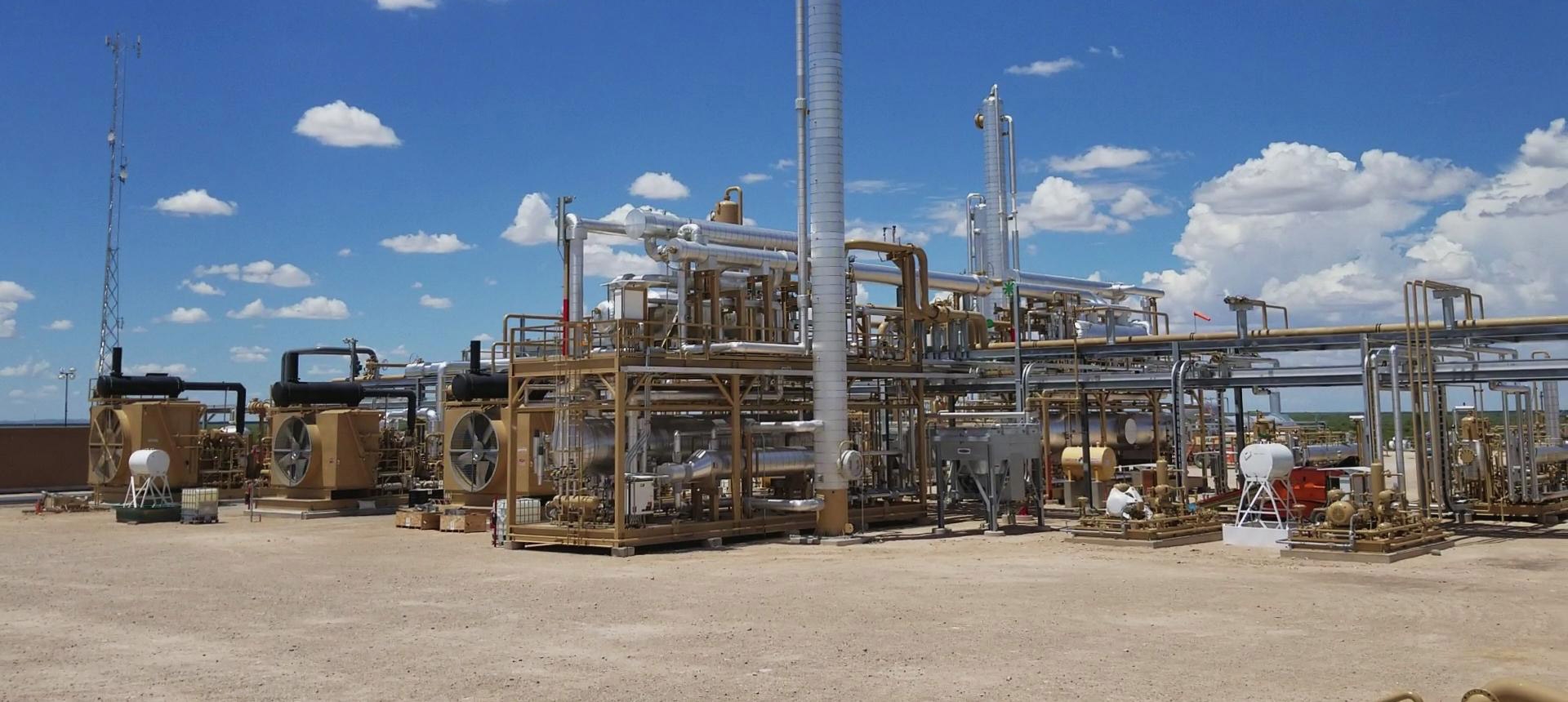Global Resources For Every Dehydration Challenge
Full Range of TEG, Mole Sieve, and Silica Gel Systems
Enerflex’s dehydration systems remove water from gas or liquid to avoid hydrate formation and condensation, meet water content specifications, and prevent corrosion.
Enerflex is an expert in dehydration systems and deploys a number of techniques, depending on the best fit for the application: liquid desiccant absorption using triethylene glycol (TEG), diethylene glycol (DEG), and tetraethylene glycol (TREG); solid desiccant adsorption using mol sieve and silica gel membrane technology; as well as mechanical refrigeration systems using ethylene glycol (EG) or methanol as the hydrate inhibitor.
Dehydration can be applied to sweet and sour natural gas applications, associated gas condensate, and natural gas liquids (NGLs).
Specialized Dehydration Industry-Wide
- Glycol Options
Glycol dehydration is an economical process that uses glycol to absorb water from natural gas. Triethylene glycol (TEG) is the most commonly used glycol among the hydrate inhibitor family — which includes diethylene glycol (DEG), monoethylene glycol (MEG), ethylene glycol (EG), and tetraethylene glycol (TREG).
Glycol dehydration can achieve an outlet gas specification of 2 lbs water / MMSCF and below. Enerflex supplies TEG dehydration units ranging from 5 to 80 GPM and higher, built to our high specification standards suitable across all environments.
- Molecular Sieve Options
The molecular sieve process uses a desiccant bead to absorb water. Because this process provides the maximum water removal from natural gas, molecular sieves can be used in high H2S environments, and are usually used when lower water specifications are requested.
Enerflex supplies molecular sieve dehydration units, up to and beyond 300 MMSCFD. Fully automated switching valves for mode control on the molecular sieve, and the bead design is optimized for maximum efficiency. Typically, these units are used to achieve outlet gas dew points less than -100°C (-150°F) or to achieve outlet gas water contents less than 0.1 PPM (parts per million).
- Silica Gel Options
Silica gel is made from sulphuric acid and sodium silicate. Silica gels work best at feed temperatures below 50°C (122°F). Because they are hydrophilic, they can be used to reach water dew point levels as low as -50°C (-60°F). Some specialty gels can effectively remove C5+ hydrocarbons.
In general, solid desiccant dehydration units such as silica gels or molecular sieves are recommended for applications where sour gas, logistics, and lower outlet water content prevents the use of TEG dehydration. Enerflex’s engineering and design expertise can help tailor a solution for your required field specifications.
Enerflex in Action
- Karak, KPK, Pakistan
70 MMSCFD Hydrocarbon Dew Point and Dehydration Control Facility
Enerflex engineered, designed, and built a 70 MMSCFD hydrocarbon dew point (HCDP) and dehydration control facility in the remote northern frontier of Pakistan. Field conditions were complex, including handling corrosive wet CO2.
Enerflex’s engineering team developed a custom process and mechanical design to enable the HCDP and dehydration facility to process wet inlet gas containing 3% CO2. The design also featured a TEG dehydration unit with 1.5 lbs of H2O per MMSCFD capacity, an SST-lined inlet separator, and a J-T valve to reduce the gas pressure from 900 lbs ASME to 600 lbs ASME.
Outcome
Enerflex commissioned the HCDP and dehydration facility on schedule, using skid-mounted units that reduced time to first gas and were cheaper to install. The customer ordered additional HCDP and dehydration facilities for future field development phases.
- Permian Basin, West Texas, USA
Long Term Contract for Natural Gas Compression Facilities with Dehydration — BOOM Solution
Enerflex signed a Build-Own-Operate-Maintain (BOOM) contract with an oil and gas producer for two compression facilities in the Permian basin. This historical oil-producing region in west Texas is being revived through horizontal drilling and multi-stage fracturing, with unconventional production of oil, solution gas, and natural gas liquids growing rapidly. The two facilities each include three reciprocating compressors, driven by natural gas engines, with slug catchers, dehydration, and H2S removal.
Outcome
The turnkey facilities were bundled with two-year operations and maintenance contracts. The construction, installation, and start-up for both turnkey rental compressor stations were completed on schedule. Monthly operations and maintenance of the compressor stations are delivered by Enerflex from its service branch in Odessa, Texas.
